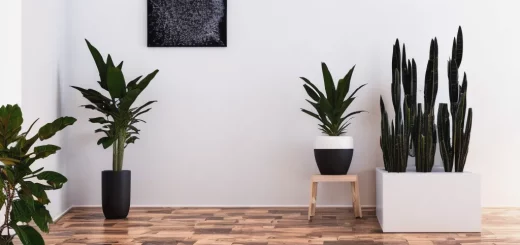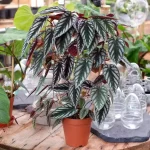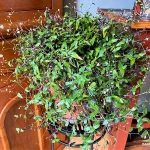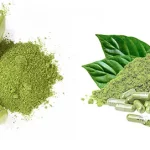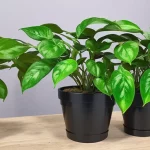The Magic of Growing Peace Lily in Water

Table of Contents
Introduction to Growing Peace Lily in Water:
The Peace Lily, scientifically known as Spathiphyllum, is not just another houseplant. It’s a symbol of tranquility, purity, and rebirth. With its elegant white blooms and lush green leaves, it has graced many homes, offices, and indoor spaces, bringing a touch of nature’s serenity indoors. But beyond its traditional potting soil habitat, there’s a rising trend that’s capturing the hearts of gardening enthusiasts: hydroponic gardening. This method, which involves growing plants in water without soil, has given the Peace Lily a new aquatic lease on life. The beauty of water-grown peace lilies is unparalleled, offering a minimalist yet vibrant aesthetic that’s both modern and timeless.
1. Understanding the Peace Lily:
1.1. Origin and History of the Peace Lily:
Native to the tropical rainforests of Central and South America, the Peace Lily has a rich history that dates back centuries. The indigenous tribes revered this plant, not just for its beauty but also for its spiritual significance. Over time, as explorers and botanists discovered this gem, it was introduced to various parts of the world. Its name, “Peace Lily,” is derived from its white, peace-flag-like spathe that surrounds the spadix, symbolizing peace and hope. Today, it’s not just a plant; it’s a testament to nature’s artistry and mankind’s appreciation of it.
1.2. Benefits of Having a Peace Lily in Your Home:
- Air Purification: One of the standout qualities of the Peace Lily is its ability to purify indoor air. NASA’s Clean Air Study highlighted the Peace Lily’s prowess in removing common indoor pollutants like benzene, formaldehyde, and ammonia. This makes it an excellent choice for homes and offices, ensuring that the air you breathe is cleaner and fresher.
- Aesthetic Appeal: The Peace Lily’s aesthetic appeal is undeniable. Its glossy green leaves paired with its pristine white blooms can elevate any space’s ambiance. Whether placed in a living room, bedroom, or office, it adds a touch of elegance and sophistication. Moreover, when grown in water, its roots create a mesmerizing underwater display, adding another dimension to its beauty.
2. Basics of Hydroponics:
2.1. What is Hydroponic Gardening?
Hydroponic gardening is a revolutionary method of growing plants without the use of soil. Instead, plants are cultivated in a nutrient-rich water solution, allowing their roots to absorb minerals and vitamins directly from the water. The term “hydroponics” originates from the Greek words “hydro” (water) and “ponos” (labor), reflecting the essence of the method: letting water do the work. Over the years, hydroponics has gained immense popularity, especially among urban gardeners, due to its space-saving, efficient, and sustainable approach.
2.2. Advantages of Growing Plants in Water:
- Space Efficiency: Hydroponic systems can be set up vertically, making them perfect for urban settings with limited space. Multiple plants can be grown in a compact area, maximizing yield per square foot.
- Faster Growth: Plants grown hydroponically often grow faster than their soil-grown counterparts. This is because they receive a consistent supply of nutrients directly, eliminating the need to search for them, as they would in soil.
- Less Water Usage: Hydroponic systems use up to 90% less water than traditional gardening. The closed-loop system recirculates water, reducing waste and conserving this precious resource.
- No Soil-Borne Diseases: By eliminating soil from the equation, you also eliminate the risk of soil-borne diseases and pests, leading to healthier plants.
3. Preparing Growing Peace Lily in Water:
3.1. Choosing the Right Peace Lily Specimen:
When transitioning to growing a peace lily in water, it’s crucial to select a healthy specimen. Look for a plant with vibrant green leaves, free from any yellowing or browning. The roots should be robust and white, indicating good health. If you’re purchasing a new plant, opt for a younger specimen, as they tend to adapt more easily to new growing conditions.
3.2. Cleaning and Preparing the Roots:
Once you’ve chosen your Peace Lily, the next step is to gently remove it from its soil. Carefully shake off any excess dirt and rinse the roots under lukewarm water to remove all traces of soil. It’s essential to be gentle during this process to avoid damaging the delicate root system. Once cleaned, inspect the roots for any signs of rot or damage and trim if necessary.
3.3. Selecting the Right Container and Water:
The container you choose for your hydroponic Peace Lily should be transparent, allowing you to monitor the water level and root health. Glass vases or jars work well. Ensure the container’s opening is wide enough to accommodate the plant but not too wide that the plant cannot support itself. As for water, it’s recommended to use distilled or rainwater to prevent any mineral buildup. If using tap water, let it sit for 24 hours to allow chlorine to evaporate before introducing the plant.
4. The Process of Transitioning to Water:
4.1. Acclimating the Peace Lily to its New Environment:
Transitioning a Peace Lily from soil to water is a delicate process that requires patience. Once you’ve prepared the roots and chosen your container, gently place the Peace Lily in the water, ensuring the roots are fully submerged but the base of the plant remains above water. Initially, the plant might experience some shock. It’s essential to place it in a location with indirect light and monitor its response. Over the next few weeks, the Peace Lily will start to acclimate, and you’ll notice new root growth adapted for its aquatic environment.
4.2. Monitoring and Changing the Water:
Water quality is paramount in hydroponic growth. For the first few weeks, it’s advisable to change the water every 5-7 days to ensure the plant has a fresh supply of oxygen and to prevent any potential buildup of pathogens. As the Peace Lily becomes more established, you can extend the time between water changes. Always ensure the water remains clear; cloudiness can be a sign of bacterial growth.
4.3. Ensuring Adequate Nutrients and Minerals:
While water provides a medium for growth, it doesn’t naturally contain the essential nutrients plants need. Every month, add a water-soluble, balanced fertilizer to the container, but at a quarter of the recommended strength. This will provide the Peace Lily with the necessary nutrients without overwhelming it. Monitor the plant’s leaves for signs of nutrient deficiencies, such as yellowing or browning, and adjust accordingly.
5. Care and Maintenance:
5.1. Light Requirements for Water-Grown Peace Lilies:
Peace Lilies thrive in indirect light. Direct sunlight can scorch their leaves, leading to yellowing or browning. For water-grown Peace Lilies, a location near a north or east-facing window is ideal. If natural light is limited, consider using a grow light, but ensure it’s positioned to mimic indirect sunlight.
5.2. Temperature and Humidity Considerations:
Being tropical plants, Peace Lilies prefer warmer temperatures, ideally between 65°F to 80°F (18°C to 27°C). They also thrive in higher humidity. If your home is dry, consider placing a humidifier near the plant or occasionally misting the leaves. Avoid drastic temperature fluctuations, as this can stress the plant.
5.3. Dealing with Potential Pests and Diseases:
While water-grown Peace Lilies are less susceptible to pests and diseases than their soil-grown counterparts, they’re not entirely immune. Watch out for signs of spider mites, aphids, or mealybugs. If you notice any pests, remove them using a soft cloth or neem oil spray. Root rot can also be a concern. If the roots appear brown and mushy, trim the affected areas and refresh the water, ensuring it’s clean and free of pathogens.
6. Troubleshooting Common Issues about Peace Lily in water:
6.1. Yellowing Leaves and What They Signify:
One of the most common issues with Peace Lilies, whether grown in soil or water, is the yellowing of leaves. Several factors can cause this:
- Over-fertilization: If you’ve been adding too much fertilizer to the water, it can lead to a buildup of salts, causing the leaves to yellow. Always ensure you’re using the recommended amount and consider flushing the roots with fresh water if over-fertilization occurs.
- Excessive Light: Peace Lilies prefer indirect light. If exposed to direct sunlight for prolonged periods, their leaves can turn yellow. Ensure your plant is positioned in a location where it receives filtered or diffused light.
- Poor Water Quality: If you’re using tap water with high chlorine or fluoride content, it can lead to yellowing leaves. Always use distilled, rainwater, or dechlorinated tap water for best results.
6.2. Root Rot and Prevention:
Root rot is a condition where the roots of the plant become brown, mushy, and emit a foul odor. It’s primarily caused by a combination of overwatering and poor water quality. In hydroponics, it can occur if the water isn’t changed regularly or if there’s insufficient oxygen for the roots. To prevent root rot:
- Regularly Change the Water: Refresh the water every 5-7 days in the initial stages and monitor its clarity.
- Aerate the Water: Consider using an aquarium air pump to introduce bubbles into the water, ensuring the roots receive adequate oxygen.
- Inspect Roots Regularly: Keep an eye on the root health, and if you notice any signs of rot, trim the affected parts immediately.
6.3. Ensuring Continuous Bloom in Water:
Achieving continuous blooms in a water-grown Peace Lily can be a bit challenging but not impossible. Here are some tips:
- Adequate Light: While Peace Lilies don’t like direct sunlight, they do need sufficient light to bloom. Ensure they receive bright, indirect light.
- Balanced Nutrients: Ensure the water contains the right balance of nutrients. Using a balanced, water-soluble fertilizer can help.
- Stress Induction: Occasionally, stressing the plant by letting it dry out a bit before refreshing the water can induce blooming. However, this should be done cautiously.
7. Benefits of Growing Peace Lily in Water:
7.1. Aesthetically Pleasing and Modern Decor Element:
Water-grown Peace Lilies offer a minimalist yet captivating aesthetic. The transparent containers allow one to see the intricate root systems, creating a mesmerizing visual that’s both modern and timeless. It’s a perfect blend of nature and contemporary design, making it a standout decor element in any space.
7.2. Reduced Need for Soil and Associated Mess:
One of the significant advantages of hydroponic growth is the elimination of soil. This means no more messy potting mixtures, no soil-borne pests, and no dirt spillage. It’s a clean, efficient, and elegant way to enjoy the beauty of the Peace Lily.
7.3. Easier Maintenance and Care:
Growing Peace Lilies in water reduces many of the common challenges associated with soil-based growth. There’s no need for repotting, less risk of overwatering, and fewer pests to deal with. With regular water changes and minimal nutrient additions, you can ensure a thriving, beautiful plant with less effort.
Conclusion:
The Peace Lily, with its graceful white blooms and lush green foliage, has long been a favorite among plant enthusiasts. But when growing Peace Lily in water, this already stunning plant takes on a new dimension of beauty. The intertwining roots, visible through clear containers, create a mesmerizing dance of nature and art. Beyond aesthetics, the benefits of water cultivation are numerous: from easier maintenance to a cleaner growing environment.
Choosing to grow a Peace Lily in water is not just about embracing a gardening trend; it’s about experiencing a unique blend of nature and innovation. It’s a testament to the adaptability of plants and the endless possibilities that await when we merge traditional knowledge with modern techniques.
For those who haven’t yet ventured into the world of hydroponic Peace Lilies, we wholeheartedly encourage you to give it a try. Dive into this magical experience and witness firsthand the wonders of water cultivation.
We’d love to hear from our readers about growing peace lily in water! If you’ve already embarked on this journey, please share your experiences, tips, and of course, photos of your water-grown Peace Lilies. For those considering this method, do you have any questions or reservations? Let’s create a community where we can learn, share, and grow together. Drop your comments below, engage with fellow readers, and let’s celebrate the beauty of the Peace Lily in all its forms.
